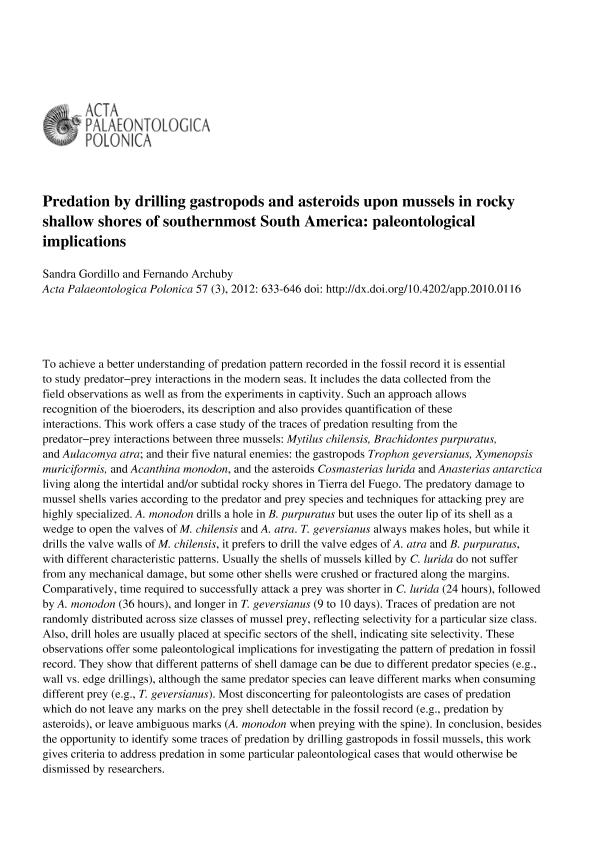Mostrar el registro sencillo del ítem
dc.contributor.author
Gordillo, Sandra

dc.contributor.author
Archuby, Fernando

dc.date.available
2018-07-17T14:33:41Z
dc.date.issued
2012-09
dc.identifier.citation
Gordillo, Sandra; Archuby, Fernando; Predation by drilling gastropods and asteroids upon mussels in rocky shallow shores of southernmost South America: Paleontological implications; Polish Academy of Sciences. Institute of Paleobiology; Acta Palaeontologica Polonica; 57; 3; 9-2012; 633-646
dc.identifier.issn
0567-7920
dc.identifier.uri
http://hdl.handle.net/11336/52364
dc.description.abstract
To achieve a better understanding of predation pattern recorded in the fossil record it is essential to study predator-prey interactions in the modern seas. It includes the data collected from the field observations as well as from the experiments in captivity. Such an approach allows recognition of the bioeroders, its description and also provides quantification of these interactions. This work offers a case study of the traces of predation resulting from the predator-prey interactions between three mussels: Mytilus chilensis, Brachidontes purpuratus, and Aulacomya atra; and their five natural enemies: the gas- tropods Trophon geversianus, Xymenopsis muriciformis, and Acanthina monodon, and the asteroids Cosmasterias lurida and Anasterias antarctica living along the intertidal and/or subtidal rocky shores in Tierra del Fuego. The predatory dam- age to mussel shells varies according to the predator and prey species and techniques for attacking prey are highly special- ized. A. monodon drills a hole in B. purpuratus but uses the outer lip of its shell as a wedge to open the valves of M. chilensis and A. atra. T. geversianus always makes holes, but while it drills the valve walls of M. chilensis, it prefers to drill the valve edges of A. atra and B. purpuratus, with different characteristic patterns. Usually the shells of mussels killed by C. lurida do not suffer from any mechanical damage, but some other shells were crushed or fractured along the margins. Comparatively, time required to successfully attack a prey was shorter in C. lurida (24 hours), followed by A. monodon (36 hours), and longer in T. geversianus (9 to 10 days). Traces of predation are not randomly distributed across size classes of mussel prey, reflecting selectivity for a particular size class. Also, drill holes are usually placed at specific sectors of the shell, indicating site selectivity. These observations offer some paleontological implications for investigating the pattern of predation in fossil record. They show that different patterns of shell damage can be due to different predator species (e.g., wall vs. edge drillings), although the same predator species can leave different marks when consuming different prey (e.g., T. geversianus). Most disconcerting for paleontologists are cases of predation which do not leave any marks on the prey shell detectable in the fossil record (e.g., predation by asteroids), or leave ambiguous marks (A. monodon when preying with the spine). In conclusion, besides the opportunity to identify some traces of predation by drilling gastropods in fossil mussels, this work gives criteria to address predation in some particular paleontological cases that would otherwise be dismissed by researchers.
dc.format
application/pdf
dc.language.iso
eng
dc.publisher
Polish Academy of Sciences. Institute of Paleobiology

dc.rights
info:eu-repo/semantics/openAccess
dc.rights.uri
https://creativecommons.org/licenses/by-nc-sa/2.5/ar/
dc.subject
Argentina
dc.subject
Asteroidea
dc.subject
Bivalvia
dc.subject
Gastropoda
dc.subject
Predation
dc.subject
Prey Selection
dc.subject
Taphonomy
dc.subject
Tierra del Fuego
dc.subject.classification
Meteorología y Ciencias Atmosféricas

dc.subject.classification
Ciencias de la Tierra y relacionadas con el Medio Ambiente

dc.subject.classification
CIENCIAS NATURALES Y EXACTAS

dc.title
Predation by drilling gastropods and asteroids upon mussels in rocky shallow shores of southernmost South America: Paleontological implications
dc.type
info:eu-repo/semantics/article
dc.type
info:ar-repo/semantics/artículo
dc.type
info:eu-repo/semantics/publishedVersion
dc.date.updated
2018-07-11T17:46:28Z
dc.identifier.eissn
1732-2421
dc.journal.volume
57
dc.journal.number
3
dc.journal.pagination
633-646
dc.journal.pais
Polonia

dc.journal.ciudad
Varsovia
dc.description.fil
Fil: Gordillo, Sandra. Consejo Nacional de Investigaciones Científicas y Técnicas. Centro Científico Tecnológico Conicet - Córdoba. Centro de Investigaciones en Ciencias de la Tierra. Universidad Nacional de Córdoba. Facultad de Ciencias Exactas Físicas y Naturales. Centro de Investigaciones en Ciencias de la Tierra; Argentina
dc.description.fil
Fil: Archuby, Fernando. Universidad Nacional de Río Negro. Sede Alto Valle. Instituto de Investigaciones en Paleobiología y Geología; Argentina
dc.journal.title
Acta Palaeontologica Polonica

dc.relation.alternativeid
info:eu-repo/semantics/altIdentifier/doi/http://dx.doi.org/10.4202/app.2010.0116
dc.relation.alternativeid
info:eu-repo/semantics/altIdentifier/url/http://www.app.pan.pl/article/item/app20100116.html
Archivos asociados
